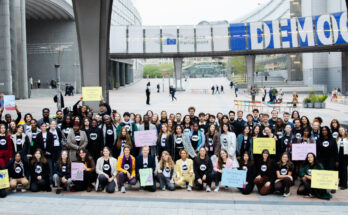As soon as he landed in Kuala Lumpur on October 26, Donald Trump was received by the Malaysian Prime Minister, Anwar Ibrahim, who, breaking security protocol, discreetly slipped into the American president’s car so he could talk alone during the journey to the official residence. A gesture which, like the one with Vladimir Putin in Alaska, harks back to the climate full of suspicion that presided over the Cold War.
The trip to Malaysia, Japan and South Korea was the most economically significant trip Trump has taken since returning to the White House. A tour aimed at testing loyalties (after marking the ground with the tariff footprint) and reducing the growing tension in the bitter trade dispute with China. A conflict that led to a volatile escalation, where the protean Trump and the hermetic Xi Jinping exchanged vetoes, concessions and ambiguous messages.
Trump returned home with what he did not hesitate to present as a harvest of successes. He has once again demonstrated his ability to “make money” on an international, multi-million dollar scale. South Korea has concluded, among other transactions, the purchase of more than one hundred Boeing aircraft for Korea Air. Japan, which agreed in September to invest $550 billion in the United States, has pledged to buy soybeans, liquefied natural gas and a fleet of Ford trucks that will ply the streets of Tokyo. For North American entities, entering the country of Toyota, Honda, Nissan, Mitsubishi and Subaru goes beyond a commercial agreement, it means putting a stake in Flanders.
Vietnam has agreed to grant preferential access to North American industrial and agricultural products without seeing its tariff share reduced by 20%, although some specific taxes yet to be decided will be eliminated. For their part, Malaysia, Thailand and Cambodia have signed a joint agreement for the extraction and processing of critical minerals. So did Thailand and Cambodia.
The highlight of the tour, however, took place in Busan, South Korea, where Trump and Xi met. Both sides announced an agreement: China agreed to resume the purchase of soybeans, to limit the production of components of fentanyl – the drug causing havoc in the United States – and to suspend, for a year, restrictions on the export of rare minerals and magnetic components imposed last October. In exchange, Washington will not implement the 100% tariffs that were due to take effect on November 1 and will reduce existing ones by 10%. As a symbolic addition, Trump acted as a mediator in the reconciliation agreement between Cambodia and Thailand – a gesture that could add points to his expected nomination for the Nobel Peace Prize – although the agreement risks becoming a dead letter, as key points remain to be defined, such as the delimitation of borders on maps.
On Beijing’s part, the greatest result was to confirm, with facts, the success of a patiently developed strategy. Over the past fifteen years, China has systematically prepared for this moment: gathering strategic data, securing control of key raw materials, and consolidating positions in vital sectors. One of his most significant moves was to secure a monopoly on the extraction and processing of rare earths, vital to the most advanced technological industries. In this regard, China today holds the main key to the global supply chain. In the process, it generated crucial economic dependencies and was able to pick the best cards in the geoeconomic game. In October he revealed one of his trump cards: the expansion of export controls.
This progress has been forged by exploiting the gaps that other powers have inexplicably left in the formation of supply networks. The United States has focused its bet on technological superiority: innovation, cutting-edge science, research, development and cutting-edge semiconductors. However, in this commitment to the intangible, he made the mistake of neglecting the material aspect that supports it: the components needed to produce the technology. This gap in planning and resources turned out to be a huge mistake. As a result, the world today faces a two-headed globalization: on the one hand, the world’s leading power dominates the design and production of advanced chips; On the other hand, the second largest economy has the essential material resources to produce them. Global interdependence, until recently celebrated as a guarantee of stability, has now been transformed into a missile weapon. We are witnessing a partial dismantling of globalization, a struggle for control of production processes, with minerals and magnets as basic ammunition.
Therefore, the US government is responding with billions of dollars of investment to encourage this sector and build supply chains decoupled from China. In this effort, collaboration with allies and partners is essential. In the Indo-Pacific, Australia and Malaysia (which hosts one of the few processing plants outside China and contributes 13% of global demand) are key players. But the new circuits require more than the capital and fiscal power of the threat, they need trust and strong relationships between partners with common interests. They also require soft power. The opposite of Donald Trump’s spirit.
When Trump started the trade war, he thought the United States’ underlying advantage would allow it to corner Beijing, as it did with the European Union. In September it activated the powerful Foreign Direct Products regulation, which limited access to the latest technologies. China’s response was immediate and the following month it conveniently removed its rare earth export controls, something it had been working on for months, replicating the US legislation almost verbatim. Xi Jinping not only resisted, but also showed his ability to pressure. And while Trump’s decisions have highlighted the enormous fiscal power of the United States, the twist of force With China, not only did it not work, it turned against its interests, forcing Washington to retreat and reconsider its approach.
It still remains unclear what Trump’s vision for Asia is. Do you think that the North American containment of China in the region hinders the MAGA project or, on the contrary, strengthens it? His words signal the continuity of interest in the Indo-Pacific. In Japan he spoke of bringing the bilateral alliance into a “new golden age” and at the opening of the ASEAN-US summit he said: “The United States will be with you one hundred percent and intends to be a strong partner and friend for many generations to come.” For now, the truce with China will allow the parties to gain time and space to reduce mutual dependence on crucial issues. Xi Jinping has demonstrated that he has the ability to apply pressure and is willing to use it without being intimidated. On the other hand, Trump’s disruptive behavior provides no guarantee of stability. Suffice it to recall the ups and downs of this year, or the fact that a few minutes before the meeting with Xi he suggested on his social network, Truth, that the United States will resume nuclear weapons tests to counter the recent ones of Russia and China. A new echo of the Cold War.



